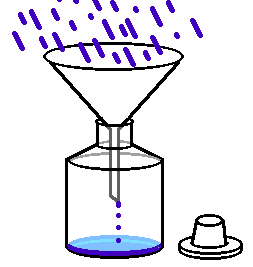
> English > Climate Encyclopaedia > Climate in Cities > basics > 3. Acid Rain > * Worksheet 2
|
|
 |
Climate in cities
Basics |
3. Acid rain
Worksheet 2:
Rain water and its acid properties
|
|
This worksheet will help you look at rainwater acidity and how acid rain affects calcium carbonate containing rocks like marble and limestone.
|
|
You will need the following materials and chemicals for the experiments:
| |
Funnel and bottle to collect rainwater with |
|
pH meter or narrow range pH paper |
| |
small glass beaker or watch glass |
|
pieces of marble (with a solid structure, not porous or crumb-like) |
|
|
100 mL beaker |
|
water |
|
1 |
hair-dryer |
|
diluted nitric acid (2N)
[C; R: 35; S: 23-26-36/37/39] |
|
1 |
high-precision balance |
|
plastic bottles to collect water samples in |
|
 |
 |
|
Figure 1: Device to collect rain water
© 2004 M. Seesing
|
|
 |
|
E1 |
Collect one or more rainwater samples. Each sample needs to be at least 50 mL in volume. Use the set up shown in Figure 1. to collect your samples.
Collect other water samples such as drinking water, water from a pond and seawater for comparison.
|
|
E2 |
Put a few mL of your rain water into a clean beaker or on a clean watch glass and measure the pH. Do the same with your other samples. This prevents your samples getting contaminated.
Write your results in the table below.
| |
|
|
No. |
sample (origin) |
pH value |
|
No. |
sample (origin) |
pH value |
|
1 |
|
|
|
5 |
|
|
|
2 |
|
|
|
6 |
|
|
|
3 |
|
|
|
7 |
|
|
|
4 |
|
|
|
8 |
|
|
|
E3 |
Put 50 mL of your rainwater into a high 100 mL beaker. Put the same amount of 2N Nitric acid into another 100 mL beaker. Measure the pH values of the solutions with a pH meter or narrow range pH paper. Find two pieces of marble which each weigh about 6 g. Make a note of the exact weight of each piece of marble. Add the marble pieces to the solutions. Make sure the pieces of marble are completely covered by the liquids. Cover the beakers with watch glasses and watch what happens to the pieces of marble.
- Write your results in the table below.
- Note down your observations below the table.
- After approximately 10 minutes, test the gas in the beakers with a burning wood stick and see if it burns.
- After 15 minutes take the pieces of marble out of the solution, rinse them thoroughly with deionized water and dry them with a hair-drier. Then weigh them accurately.
- Measure the pH of the remaining solutions.
- Put the marble pieces back into the solutions and cover the beakers with watch glasses. After a few days clean, dry and weigh the pieces of marble again and measure the pH values of the solutions.
|
| |
measurement 1 |
measurement 2 |
|
solution tested |
|
|
|
mass of the piece of marble
before the experiment |
|
|
|
pH value of the solution
before the experiment |
|
|
|
mass of the piece of marble
after 15 min |
|
|
|
pH value of the solution
after 15 min |
|
|
|
mass of the piece of marble
after ___ days |
|
|
|
pH value of the solution
after ___ days |
|
|
|
The gas inside the beaker: |
®burns
®puts out the flame
®none of the above |
®burns
®puts out the flame
®none of the above |
|
About this page:
authors: M. Seesing, M. Tausch - Universitšt Duisburg-Essen, Duisburg, Germany
last update: 2004-05-24
|
 > English > Climate Encyclopaedia > Climate in Cities > basics > 3. Acid Rain > * Worksheet 2
> English > Climate Encyclopaedia > Climate in Cities > basics > 3. Acid Rain > * Worksheet 2
